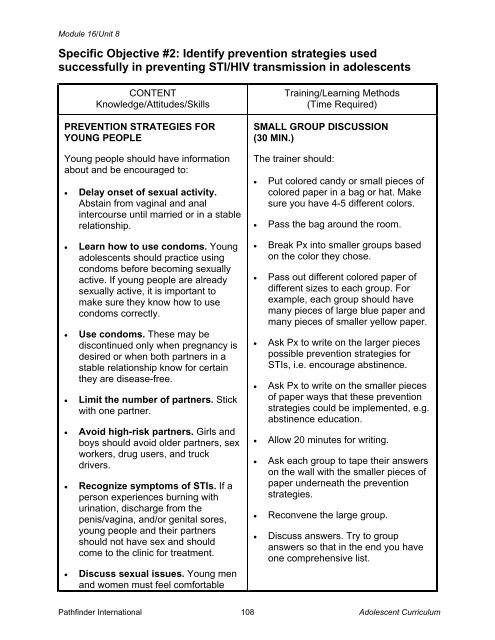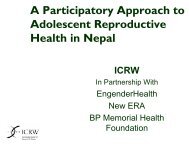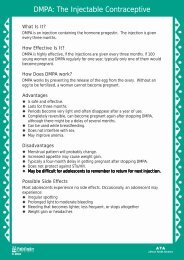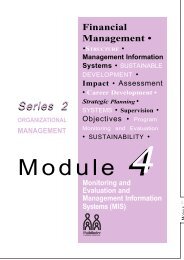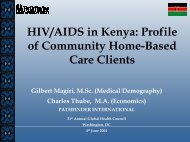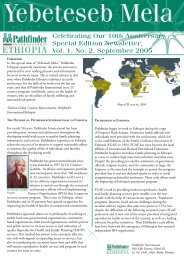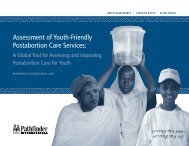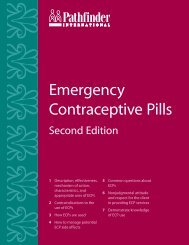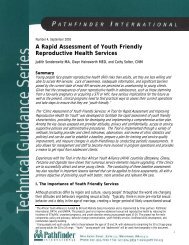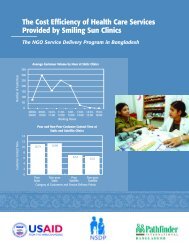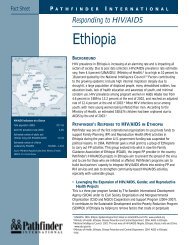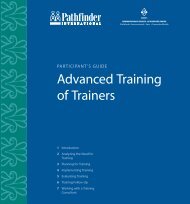reproductive health services for adolescents - Pathfinder International
reproductive health services for adolescents - Pathfinder International
reproductive health services for adolescents - Pathfinder International
Create successful ePaper yourself
Turn your PDF publications into a flip-book with our unique Google optimized e-Paper software.
Module 16/Unit 8<br />
Specific Objective #2: Identify prevention strategies used<br />
successfully in preventing STI/HIV transmission in <strong>adolescents</strong><br />
CONTENT<br />
Knowledge/Attitudes/Skills<br />
PREVENTION STRATEGIES FOR<br />
YOUNG PEOPLE<br />
Young people should have in<strong>for</strong>mation<br />
about and be encouraged to:<br />
• Delay onset of sexual activity.<br />
Abstain from vaginal and anal<br />
intercourse until married or in a stable<br />
relationship.<br />
• Learn how to use condoms. Young<br />
<strong>adolescents</strong> should practice using<br />
condoms be<strong>for</strong>e becoming sexually<br />
active. If young people are already<br />
sexually active, it is important to<br />
make sure they know how to use<br />
condoms correctly.<br />
• Use condoms. These may be<br />
discontinued only when pregnancy is<br />
desired or when both partners in a<br />
stable relationship know <strong>for</strong> certain<br />
they are disease-free.<br />
• Limit the number of partners. Stick<br />
with one partner.<br />
• Avoid high-risk partners. Girls and<br />
boys should avoid older partners, sex<br />
workers, drug users, and truck<br />
drivers.<br />
• Recognize symptoms of STIs. If a<br />
person experiences burning with<br />
urination, discharge from the<br />
penis/vagina, and/or genital sores,<br />
young people and their partners<br />
should not have sex and should<br />
come to the clinic <strong>for</strong> treatment.<br />
• Discuss sexual issues. Young men<br />
and women must feel com<strong>for</strong>table<br />
Training/Learning Methods<br />
(Time Required)<br />
SMALL GROUP DISCUSSION<br />
(30 MIN.)<br />
The trainer should:<br />
• Put colored candy or small pieces of<br />
colored paper in a bag or hat. Make<br />
sure you have 4-5 different colors.<br />
• Pass the bag around the room.<br />
• Break Px into smaller groups based<br />
on the color they chose.<br />
• Pass out different colored paper of<br />
different sizes to each group. For<br />
example, each group should have<br />
many pieces of large blue paper and<br />
many pieces of smaller yellow paper.<br />
• Ask Px to write on the larger pieces<br />
possible prevention strategies <strong>for</strong><br />
STIs, i.e. encourage abstinence.<br />
• Ask Px to write on the smaller pieces<br />
of paper ways that these prevention<br />
strategies could be implemented, e.g.<br />
abstinence education.<br />
• Allow 20 minutes <strong>for</strong> writing.<br />
• Ask each group to tape their answers<br />
on the wall with the smaller pieces of<br />
paper underneath the prevention<br />
strategies.<br />
• Reconvene the large group.<br />
• Discuss answers. Try to group<br />
answers so that in the end you have<br />
one comprehensive list.<br />
<strong>Pathfinder</strong> <strong>International</strong><br />
108<br />
Adolescent Curriculum


